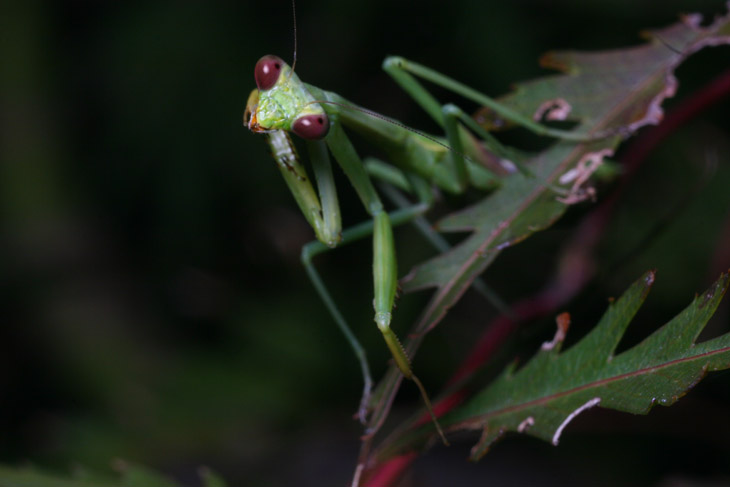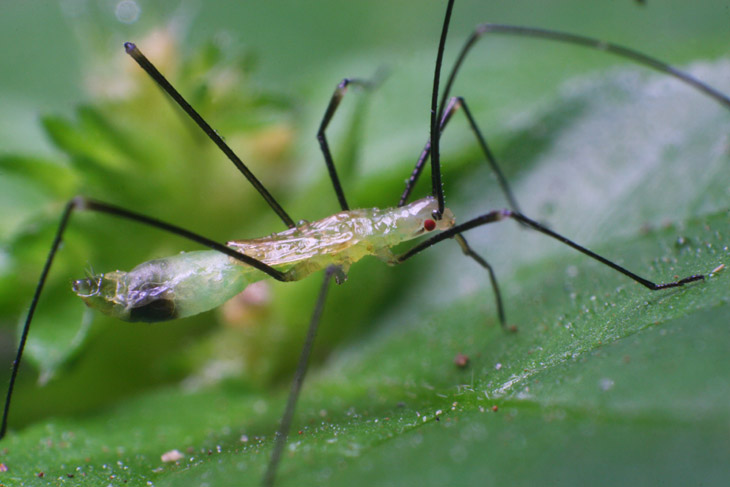
Still involved in many other things right now, so here are a handful of images from the recent past that just never got into blog posts, for one reason or another – some of which may become obvious.
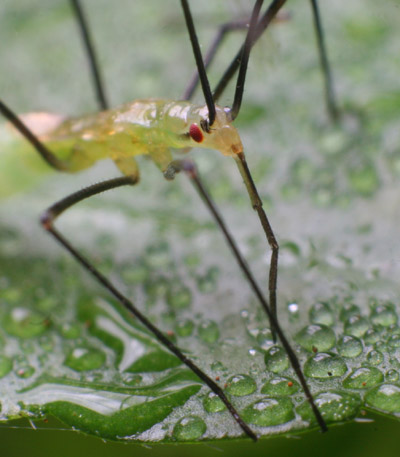 First off we have the most recent images from just a few days ago, an unidentified Hemipteran nymph, quite a small one. I am inclined to call it an assassin bug, but so far I have found no species that matches this coloration (the black legs in particular.) Oddly enough, it was spotted on the kitchen counter, with no good guesses as to how it arrived there, though it might have hitchhiked in on a tomato or basil leaf. It measured just 6mm in body length, and appreciated the water provided by the misting bottle, so it may have been indoors for a while.
First off we have the most recent images from just a few days ago, an unidentified Hemipteran nymph, quite a small one. I am inclined to call it an assassin bug, but so far I have found no species that matches this coloration (the black legs in particular.) Oddly enough, it was spotted on the kitchen counter, with no good guesses as to how it arrived there, though it might have hitchhiked in on a tomato or basil leaf. It measured just 6mm in body length, and appreciated the water provided by the misting bottle, so it may have been indoors for a while.
The long antennae certainly lend them the air of an arachnid, and this may not be coincidental, scamming the predators that don’t like spiders. Or it may simply be a way to seek food while avoiding mites and parasites – you got me. As yet, I’m not even sure if this is a predator or feeds from plants; that proboscis could be used for either, though from the owner’s close resemblance to the pale green assassin bug (Zelus luridus,) I’m leaning towards it having the same habits.
Below, a little bit more of a scale shot, as I deposited it on a geranium bud after the preceding studio images. For some reason, the Canon 30D (at least) seems to over-saturate the reds, and I’m going to have to see what I might be able to do about that. It’s one thing to have vivid colors, but another to look completely unnatural…
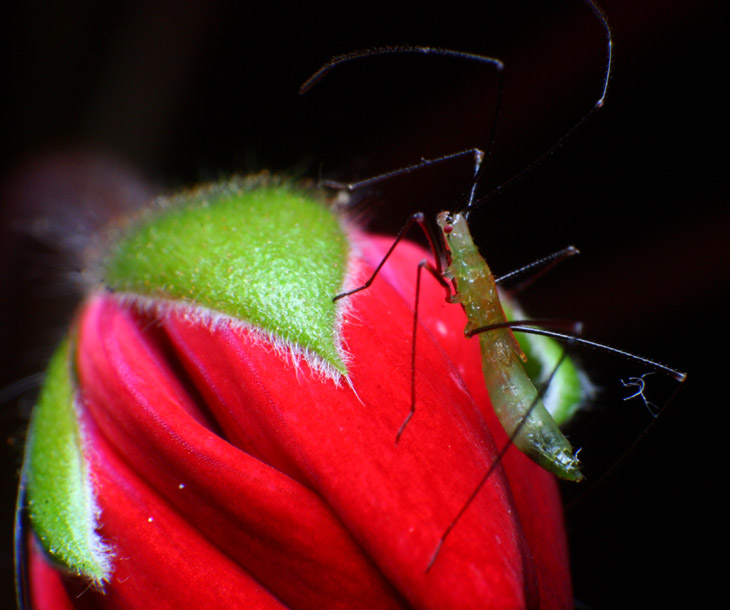
One of the few bits that I’ve accomplished on the backyard pond has been casting a couple of upper ‘pools’ out of concrete, one just large enough to hold a small water pump for a multi-stage waterfall/cascade (there will be a second pump in the pond itself, feeding into this pool.) While there have been frogs in the main pond off and on throughout the season, I found that a small one had decided, for a few days at least, to hang out in the concrete pool. Naturally, it submerged as soon as I drew close, but since the pool is smaller than the average birdbath and holds about 10cm of water, the amphibian wasn’t completely evading detection. I simply sat down nearby and waited it out for a quick portrait.
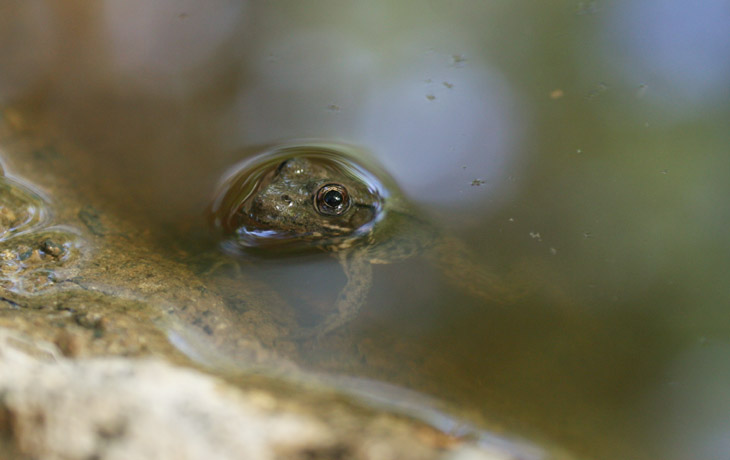
This is a green frog (Lithobates clamitans,) and a small one at that, perhaps 5 or 6cm in body length; I get the impression of a teenager camping out in the yard in a defiant display of semi-independence, though I did not actually see any tattoos or piercings…
But while we’re here, I’m going to throw up a couple of illustrative images. Both of the following were taken from the same position (handheld, so not exactly the same, but very close.) The only change was the focus distance.

The one above is focused on the frog itself, and a hint of the incomplete tree canopy can be seen reflected in the water. Below, I changed focus to the reflection itself which, I have to point out, is not the distance to the water surface, but bounced off of it all the way to the trees.
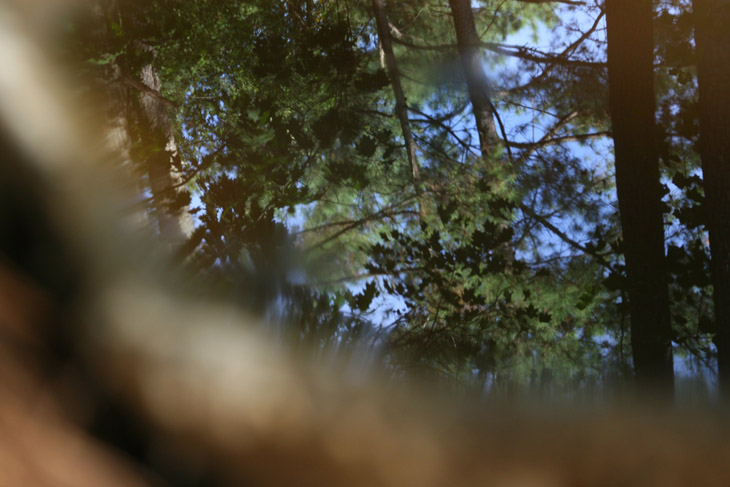
The frog is still there, but defocused to almost complete obscurity. I was shooting from about a meter away from the frog, but the trees themselves were in excess of ten meters off, requiring a radical difference in focus. What also happens in such a case, visible here to some extent, is that focusing actually produces a faint zooming effect, and you may see this a lot in macro work. When composing, you might lean in closer until the subject fits the frame well, but as the focus changes commensurately, it changes the size of the subject within the frame, and you may need to readjust slightly. But certainly, getting both the frog and the reflection focused simultaneously would take a huge depth of field, one that no lens is likely to produce at this distance from the subject.
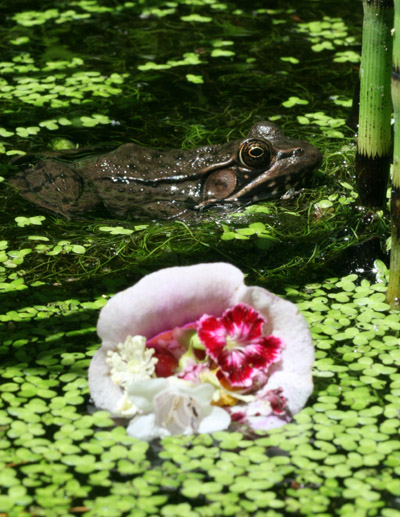 We’ll stick with the frogs for a moment longer before changing the subject, as I show off a photo that I haven’t actually had a good use for yet. This was taken at the NC Botanical Garden, in a pond even smaller than mine (the main one, not the concrete pool above,) and is exactly as found, even though you don’t believe me. Hey, if the frog is going to pose that way and the light is good on both the frog and the flower, who am I to pass that up? This pond, in fact, is what I am patterning my own after, including the scouring rush reeds visible at right, though I’m not sure how well the duckweed (the little spot leaves all over the place) will fare with the cascade feeding in, since this pond lacks such a thing. But the frogs adore it, and that’s part of the reason why I’m putting one in. It’s simply a shame that the tree canopy glimpsed above is so complete that there was no place to put the pond that had good light.
We’ll stick with the frogs for a moment longer before changing the subject, as I show off a photo that I haven’t actually had a good use for yet. This was taken at the NC Botanical Garden, in a pond even smaller than mine (the main one, not the concrete pool above,) and is exactly as found, even though you don’t believe me. Hey, if the frog is going to pose that way and the light is good on both the frog and the flower, who am I to pass that up? This pond, in fact, is what I am patterning my own after, including the scouring rush reeds visible at right, though I’m not sure how well the duckweed (the little spot leaves all over the place) will fare with the cascade feeding in, since this pond lacks such a thing. But the frogs adore it, and that’s part of the reason why I’m putting one in. It’s simply a shame that the tree canopy glimpsed above is so complete that there was no place to put the pond that had good light.
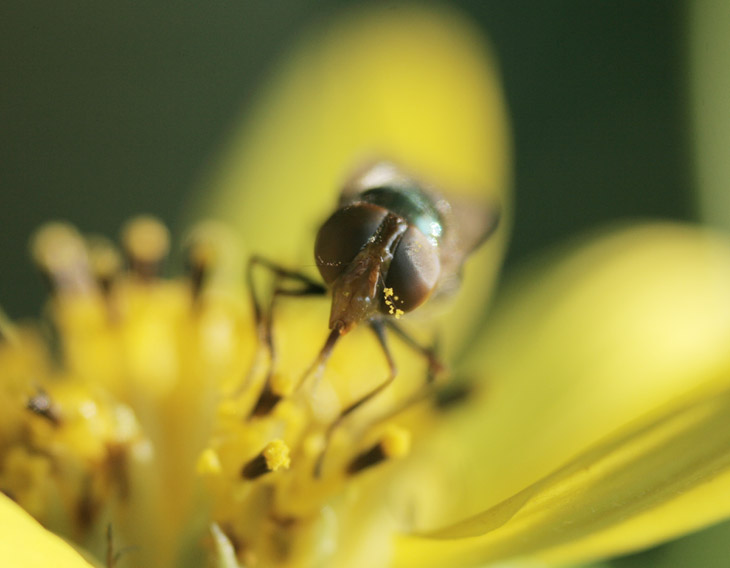
Taken several weeks back now on a student outing, I’m going to take a stab at this being some form of syrphid fly, and leave it at that. It was largely a grab shot as the fly scampered across the flower, but I liked the pollen on the compound eyes and endeavored to get that into focus while shooting in natural light – as you can see, I wasn’t quite bang on. I think we imagine that such a thing obscuring our vision would be very annoying, but who knows how an insect views it? Yet, soon afterward, the fly paused and wiped it away with a foreleg, at least making me feel better.
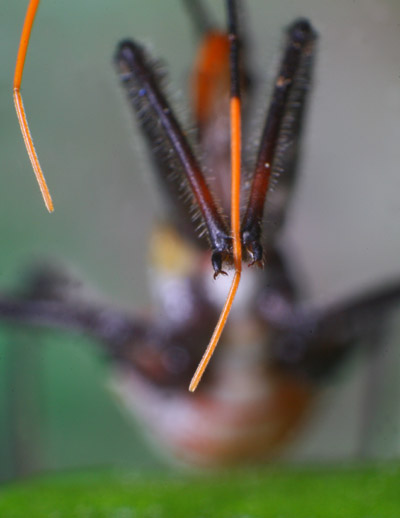 Somehow, I missed putting this one up with the others when I posted about this subject in July. I won’t blame you for being confused by what you’re seeing here, if you are – if not, good on ya! This is a wheel bug (Arilus cristatus) seen head-on like the fly above, cleaning its antenna by clasping it between both forelegs and drawing it through; they actually have small combs on the forelegs specifically for this purpose. It’s a surprisingly deliberate and meticulous action for an arthropod, or so we might think anyway, but undoubtedly necessary for them to function properly – specialized body parts and associated actions don’t evolve for no reason. The bug repeated the action several times, which was good because this is high magnification and pinning down the focus while the insect was moving was challenging, to put it mildly – I tossed several frames where I missed. And I certainly didn’t plan it this way, but catching the one foot against the bright spot on the thorax just made those details stand out so much better. Remember the post where I talked about taking enough frames to capture what was needed? Yeah…
Somehow, I missed putting this one up with the others when I posted about this subject in July. I won’t blame you for being confused by what you’re seeing here, if you are – if not, good on ya! This is a wheel bug (Arilus cristatus) seen head-on like the fly above, cleaning its antenna by clasping it between both forelegs and drawing it through; they actually have small combs on the forelegs specifically for this purpose. It’s a surprisingly deliberate and meticulous action for an arthropod, or so we might think anyway, but undoubtedly necessary for them to function properly – specialized body parts and associated actions don’t evolve for no reason. The bug repeated the action several times, which was good because this is high magnification and pinning down the focus while the insect was moving was challenging, to put it mildly – I tossed several frames where I missed. And I certainly didn’t plan it this way, but catching the one foot against the bright spot on the thorax just made those details stand out so much better. Remember the post where I talked about taking enough frames to capture what was needed? Yeah…
And one last one, that just didn’t fit in anywhere else (and probably doesn’t here either.)
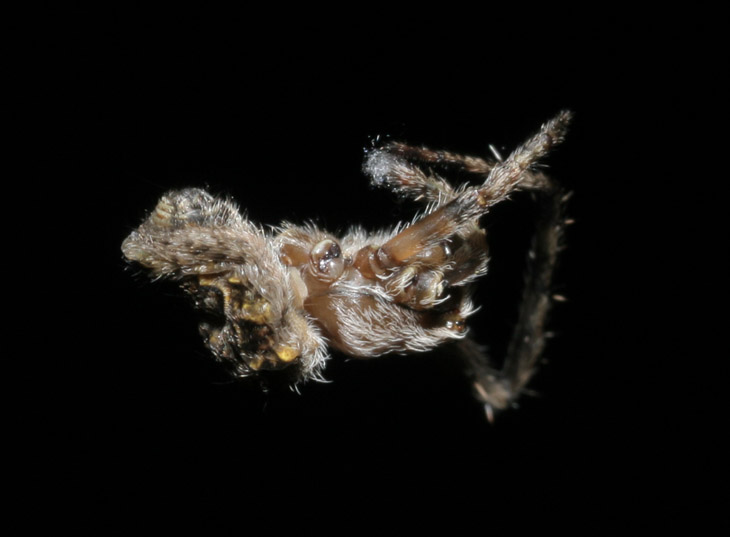
On the same outing as the maybe-syrphid fly above, I spotted this small spider clambering up a web strand just off the walking path, noticeable partially because I’m me, but also because I was almost certain it had only two legs. One examining the photos, I can see three, so it’s not quite as bad off as I originally believed, but still not good, and the motion it was using to climb back up its own web was most unspiderlike. I’m fairly certain this is a variety of cribellate orb weaver (family Uloboridae,) the only spider species that has no venom (I’ll let you speculate on whether that played any part in this specimen’s sorry shape.) I used the flash this time, mostly because I couldn’t possibly stop the action in the deep shade where the spider was, and while I did get some nice sharp images, they still don’t illustrate things very well – you’re seeing the spider from the left side, belly up, abdomen to the left of the frame (it always looks like that, I believe) and a couple of the eyes visible at the base of the shadowed leg. One stump is plainly visible. It would be easy to believe these handicaps would have some effect on the energy of the spider, but not to my observations; the bug-eater was ripping right along. By the way, this was taken at 8:36 am on a bright day, but 1/250 second at f16, aiming into deep shade, was enough to render the background pure black, even at ISO 320 – it’s that ‘every macro photo is taken at night’ trait that can be hard to overcome. Just for kicks, I went in and played with the light levels in the image to see if anything could be discerned in the background, with no luck at all; it’s black. Black black black. It’s just a shame that I couldn’t get a better view of the spider, but it was plugging along so gamely that I didn’t feel right in collecting it for studio work. I’ve spotted a couple of cribellates nearby, so at some point I may be back with better illustrations of what one is supposed to look like. I know you just can’t wait.
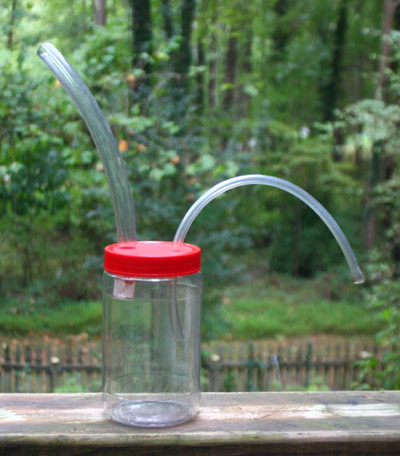 If you are not familiar with entomology, you may have a variety of responses to this statement, including, “Congratulations – Al is a big boy now!” and, “Isn’t that a slang term for female genitalia?” But no, that’s cooter… actually, it probably could be either, since it seems anything can be a slang term for female genitalia if you say it right. Doesn’t matter, because that’s not what I’m talking about, and anyway, I wouldn’t make one. That’s… just…
If you are not familiar with entomology, you may have a variety of responses to this statement, including, “Congratulations – Al is a big boy now!” and, “Isn’t that a slang term for female genitalia?” But no, that’s cooter… actually, it probably could be either, since it seems anything can be a slang term for female genitalia if you say it right. Doesn’t matter, because that’s not what I’m talking about, and anyway, I wouldn’t make one. That’s… just… It works amazingly well, and takes very little inhalation to snag the target. I had used a larger mouth tube to be able to draw an insect all the way up the capture tube easily, but this really doesn’t seem necessary. I would recommend, however, ensuring that it’s easy to distinguish which tube is which, lest you put the wrong one in your mouth and a) mash your target bug against the gauze filter and think that you missed it, and/or b) end up inhaling a previous capture. Also, per the advice of someone else, the jar should be clear but not glass, just for safety’s sake.
It works amazingly well, and takes very little inhalation to snag the target. I had used a larger mouth tube to be able to draw an insect all the way up the capture tube easily, but this really doesn’t seem necessary. I would recommend, however, ensuring that it’s easy to distinguish which tube is which, lest you put the wrong one in your mouth and a) mash your target bug against the gauze filter and think that you missed it, and/or b) end up inhaling a previous capture. Also, per the advice of someone else, the jar should be clear but not glass, just for safety’s sake.





















































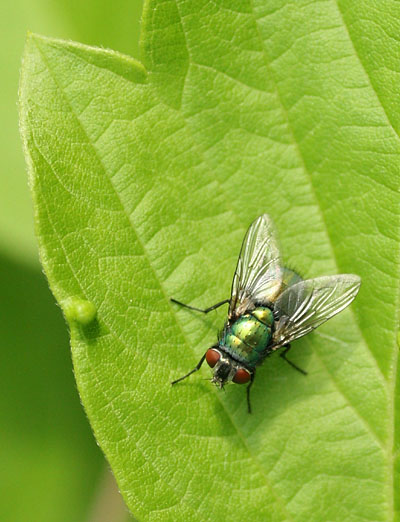 Perhaps not everyone’s idea of cheerful color, and it was a grab shot as I was pursuing other subjects, but it’s vivid – ya gotta give it that.
Perhaps not everyone’s idea of cheerful color, and it was a grab shot as I was pursuing other subjects, but it’s vivid – ya gotta give it that.
 The frame above, by the way, is tightly cropped, and slightly less than full resolution. This one, the same image, shows exactly how big the moon appears in the frame at 453mm focal length, just so you know what kind of magnification it takes for moon photos. For exposure details, 1/100 second at f11, ISO 100 – the typical exposure for full moon shots, provided that it’s not faintly dimmed by haze (basically, at f11, shutter speed should be 1/ISO, what’s often called, “Moony 11”.) A stop or so brighter would have been better, given the glow easily visible around it when observed.
The frame above, by the way, is tightly cropped, and slightly less than full resolution. This one, the same image, shows exactly how big the moon appears in the frame at 453mm focal length, just so you know what kind of magnification it takes for moon photos. For exposure details, 1/100 second at f11, ISO 100 – the typical exposure for full moon shots, provided that it’s not faintly dimmed by haze (basically, at f11, shutter speed should be 1/ISO, what’s often called, “Moony 11”.) A stop or so brighter would have been better, given the glow easily visible around it when observed.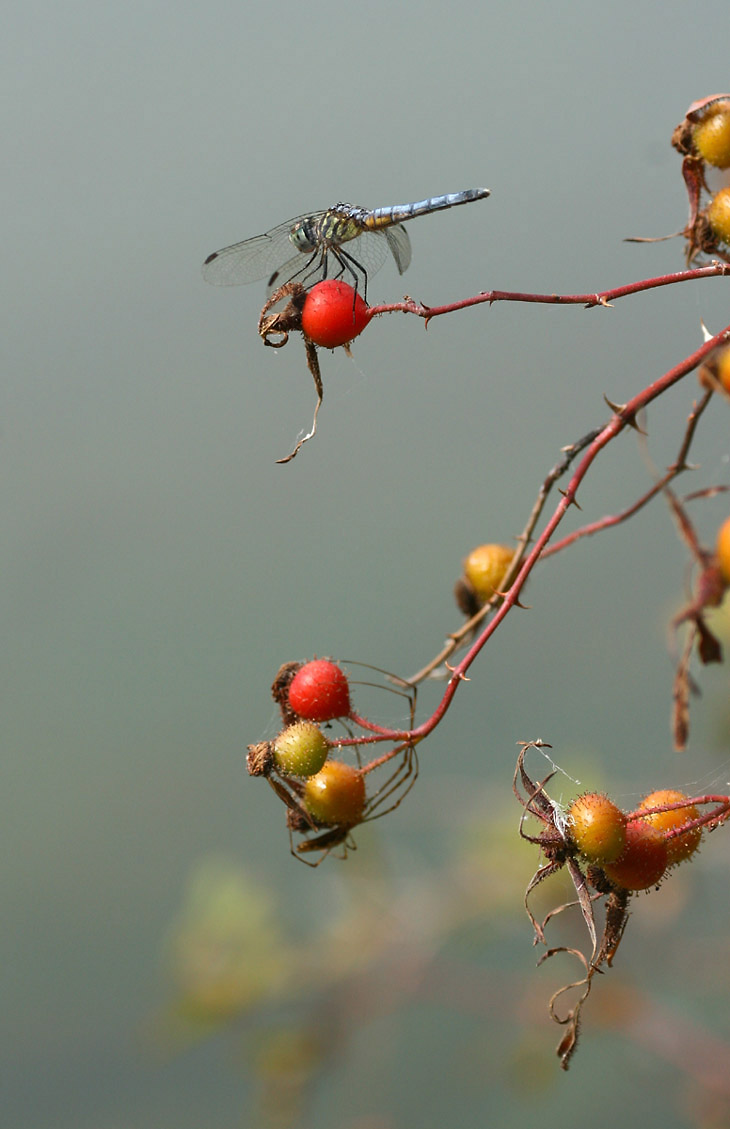
 The mantis from the previous post stayed trapped by the rain for several days, finally leaving its position early this afternoon – naturally while I wasn’t watching. While I was wandering around the backyard, hoping to find where she’d gotten off to, I spotted something else, which I won’t identify and simply let you look at the image to the left to try and find on your own. It gives a pretty good idea of what I saw at first, and the kind of things I pay attention to because they often enough lead to new critters to photograph.
The mantis from the previous post stayed trapped by the rain for several days, finally leaving its position early this afternoon – naturally while I wasn’t watching. While I was wandering around the backyard, hoping to find where she’d gotten off to, I spotted something else, which I won’t identify and simply let you look at the image to the left to try and find on your own. It gives a pretty good idea of what I saw at first, and the kind of things I pay attention to because they often enough lead to new critters to photograph. I am going to identify this as a Cope’s grey treefrog (Hyla chrysoscelis,) with reservations – they cannot be distinguished from the common grey treefrog visually, but so far, the Cope’s is the only species that I’ve confirmed we have around here, solely by
I am going to identify this as a Cope’s grey treefrog (Hyla chrysoscelis,) with reservations – they cannot be distinguished from the common grey treefrog visually, but so far, the Cope’s is the only species that I’ve confirmed we have around here, solely by  Remember, look at your thumb – the distance between the tip and the crease of the joint is how long this little bugger is (unless your hands are way different in size from mine.) But this gives a good view of those little blobby pads at the tips of the toes, which help treefrogs cling to such surfaces, and the brilliant yellow lining of the hind legs which often remain hidden from sight. Don’t ask me the purpose of that coloration, because I could only speculate, and poorly at that.
Remember, look at your thumb – the distance between the tip and the crease of the joint is how long this little bugger is (unless your hands are way different in size from mine.) But this gives a good view of those little blobby pads at the tips of the toes, which help treefrogs cling to such surfaces, and the brilliant yellow lining of the hind legs which often remain hidden from sight. Don’t ask me the purpose of that coloration, because I could only speculate, and poorly at that.


 First off we have the most recent images from just a few days ago, an unidentified Hemipteran nymph, quite a small one. I am inclined to call it an assassin bug, but so far I have found no species that matches this coloration (the black legs in particular.) Oddly enough, it was spotted on the kitchen counter, with no good guesses as to how it arrived there, though it might have hitchhiked in on a tomato or basil leaf. It measured just 6mm in body length, and appreciated the water provided by the misting bottle, so it may have been indoors for a while.
First off we have the most recent images from just a few days ago, an unidentified Hemipteran nymph, quite a small one. I am inclined to call it an assassin bug, but so far I have found no species that matches this coloration (the black legs in particular.) Oddly enough, it was spotted on the kitchen counter, with no good guesses as to how it arrived there, though it might have hitchhiked in on a tomato or basil leaf. It measured just 6mm in body length, and appreciated the water provided by the misting bottle, so it may have been indoors for a while.



 We’ll stick with the frogs for a moment longer before changing the subject, as I show off a photo that I haven’t actually had a good use for yet. This was taken at the
We’ll stick with the frogs for a moment longer before changing the subject, as I show off a photo that I haven’t actually had a good use for yet. This was taken at the 
 Somehow, I missed putting this one up with the others when I
Somehow, I missed putting this one up with the others when I 
 I had originally identified this flower as a winter aconite, Eranthis hyemalis, but now I’m pretty sure that’s wrong – the leaves aren’t like that, and no image I can find shows this green translucent ‘berry’ springing from the middle. So if you know what this is, feel free to enlighten me. All I can say right now is that these are tiny flowers perhaps a centimeter across, that appear very early in the spring – last year they got
I had originally identified this flower as a winter aconite, Eranthis hyemalis, but now I’m pretty sure that’s wrong – the leaves aren’t like that, and no image I can find shows this green translucent ‘berry’ springing from the middle. So if you know what this is, feel free to enlighten me. All I can say right now is that these are tiny flowers perhaps a centimeter across, that appear very early in the spring – last year they got 
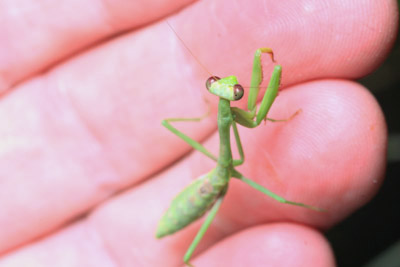 While coaxing it around for a better view, it scrambled onto my hand without a qualm, and I juggled the camera around one-handed for a quick scale shot. Then, as I tried to convince it to get back onto the maple tree, it resisted playfully and trotted up my arm all the way to the short sleeve cuff, before I could brush it back onto the tree. It would seem I now have a reputation for making mantids famous. Either that or my beard looked like a tasty bug – your call.
While coaxing it around for a better view, it scrambled onto my hand without a qualm, and I juggled the camera around one-handed for a quick scale shot. Then, as I tried to convince it to get back onto the maple tree, it resisted playfully and trotted up my arm all the way to the short sleeve cuff, before I could brush it back onto the tree. It would seem I now have a reputation for making mantids famous. Either that or my beard looked like a tasty bug – your call.